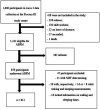Are ambulatory blood pressure parameters associated more with central adiposity than with total adiposity? Results of the ELSA-Brasil study
- PMID: 38155992
- PMCID: PMC10752922
- DOI: 10.3389/fcvm.2023.1286726
Are ambulatory blood pressure parameters associated more with central adiposity than with total adiposity? Results of the ELSA-Brasil study
Abstract
Background: Worldwide obesity has a high prevalence, as well as carries a high risk of several chronic diseases, including hypertension. Studies of the association between obesity and ambulatory blood pressure (BP) are scarce and most use only body mass index (BMI) as indicator of adiposity. Thus, we aimed to examine for associations between total and central adiposity and ambulatory BP parameters (BP means and variability, nocturnal dipping and morning surge) among participants in the Brazilian Longitudinal Study of Adult Health (ELSA-Brasil).
Methods: This cross-sectional study (2012-2014) used a subsample of participants (n = 812) of ELSA-Brasil who underwent 24-hour ambulatory BP monitoring to assess systolic and diastolic BP (SBP and DBP, respectively) over 24-hour periods and sub-periods. Indicators for total adiposity were BMI and body fat (BF) and, for central adiposity, waist circumference (WC) and waist-to-height ratio (WHR). Associations were tested using crude and adjusted gamma and logistic regression.
Results: Overweight (BMI) and abdominal obesity (WC and WHR) associated positively with mean 24-hour (Coef = 2.71, 3.09 and 4.00, respectively), waking (Coef = 2.87, 3.26 and 4.16, respectively), and sleeping (Coef = 2.30, 2.74 and 3.50, respectively) SBP; mean DBP associated with high WHR in these three periods (Coef = 2.00, 2.10 and 1.68, respectively) and with WC in the waking period (Coef = 1.44). Overweight and abdominal obesity (WC and WHR) were positively associated with SBP variability over 24 h (Coef = 0.53, 0.45 and 0.49, respectively) and in sleep (Coef = 0.80, 0.74 and 0.59, respectively), and with DBP variability in 24 h (Coef = 0.64, 0.73 and 0.58, respectively), wakefulness (Coef = 0.50, 0.52 and 0.52, respectively) and sleep (Coef = 0.53, 0.45 and 0.49); excess BF associated positively with DBP variability over 24 h (Coef = 0.43) and in wakefulness (Coef = 0.38). Lastly, high WHR and excess BF were associated with higher odds of extreme dipping (OR = 1.03 for both), while high WC and WHR associated with higher odds of exacerbated diastolic morning surge (OR = 3.18 and 3.66, respectively).
Conclusion: Indicators of adiposity were associated with the BP means and variability, nocturnal dipping and morning surge, with more substantial results for indicators of central adiposity that the others.
Keywords: adiposity; ambulatory blood pressure monitoring; morning surge; nocturnal dipping; variability.
© 2023 de Souza, Griep, Hermsdorff, Fonseca and Juvanhol.
Conflict of interest statement
The authors declare that the research was conducted in the absence of any commercial or financial relationships that could be construed as a potential conflict of interest. The author(s) declared that they were an editorial board member of Frontiers, at the time of submission. This had no impact on the peer review process and the final decision.
Figures
Similar articles
-
Food consumption by degree of processing is associated with nocturnal dipping and blood pressure variability: The ELSA-Brasil study.Nutr Metab Cardiovasc Dis. 2023 Jul;33(7):1377-1388. doi: 10.1016/j.numecd.2023.02.007. Epub 2023 Feb 19. Nutr Metab Cardiovasc Dis. 2023. PMID: 37236898
-
A comparison of body mass index and waist-to-hip ratio as indicators of hypertension risk in an urban Argentine population: a hospital-based study.Nutr Metab Cardiovasc Dis. 2005 Aug;15(4):310-5. doi: 10.1016/j.numecd.2005.03.001. Nutr Metab Cardiovasc Dis. 2005. PMID: 16054556
-
Sex-specific associations of birth weight with measures of adiposity in mid-to-late adulthood: the Brazilian Longitudinal Study of Adult Health (ELSA-Brasil).Int J Obes (Lond). 2016 Aug;40(8):1286-91. doi: 10.1038/ijo.2016.76. Epub 2016 Apr 28. Int J Obes (Lond). 2016. PMID: 27121250 Free PMC article.
-
Prevalence of obesity and overweight, its clinical markers and associated factors in a high risk South-Asian population.BMC Obes. 2015 Mar 18;2:16. doi: 10.1186/s40608-015-0044-6. eCollection 2015. BMC Obes. 2015. PMID: 26217531 Free PMC article.
-
Body mass index, abdominal adiposity and blood pressure: consistency of their association across developing and developed countries.Int J Obes Relat Metab Disord. 2002 Jan;26(1):48-57. doi: 10.1038/sj.ijo.0801854. Int J Obes Relat Metab Disord. 2002. PMID: 11791146
Cited by
-
Abdominal obesity prevalence in Latin America: a systematic review and meta-analysis comparing ATP III and IDF criteria.Front Endocrinol (Lausanne). 2025 Jun 17;16:1562060. doi: 10.3389/fendo.2025.1562060. eCollection 2025. Front Endocrinol (Lausanne). 2025. PMID: 40600008 Free PMC article.
References
-
- World Health Organization. Disponível em. Available at: https://www.who.int/news/item/04-03-2022-world-obesity-day-2022-accelera... (2022).
-
- Jardim PCBV, Gondim MRP, Monego ET, Moreira HG, Vitorino PVO, Souza WKSB, et al. Hipertensão Arterial e Alguns Fatores de Risco em uma Capital Brasileira. Arq Br Cardiol. (2007) 88(4):452–7. 10.1590/S0066-782X2007000400015 - DOI
-
- Peixoto MRG, Cordeiro MM, Ferreira VR, Cardoso CKR, Crispin PAA. Ganho de peso na vida adulta: preditor da hipertensão arterial?. Cad saúde colet. (2017) 25(1):58–64. 10.1590/1414-462x201700010023 - DOI
-
- Fedecostante M, Spanella F, Giullieti F, Espinosa E, Dessì-Fulgheri P, Sarzani R. Associations between body mass index, ambulatory blood pressure findings, and changes in cardiac structure: relevance of pulse and nighttime pressures. J Clin Hypertens. (2015) 17:147–53. 10.1111/jch.12463 - DOI - PMC - PubMed
LinkOut - more resources
Full Text Sources
Miscellaneous


